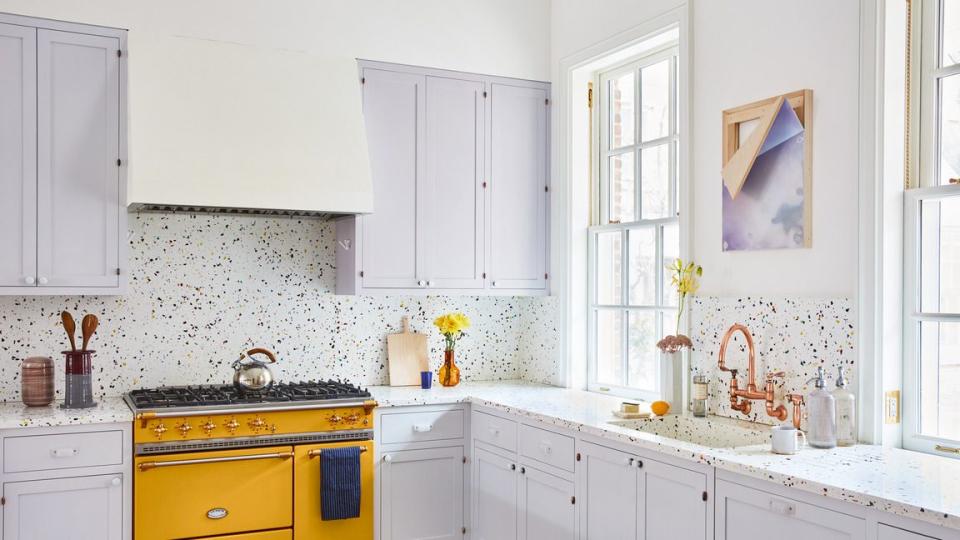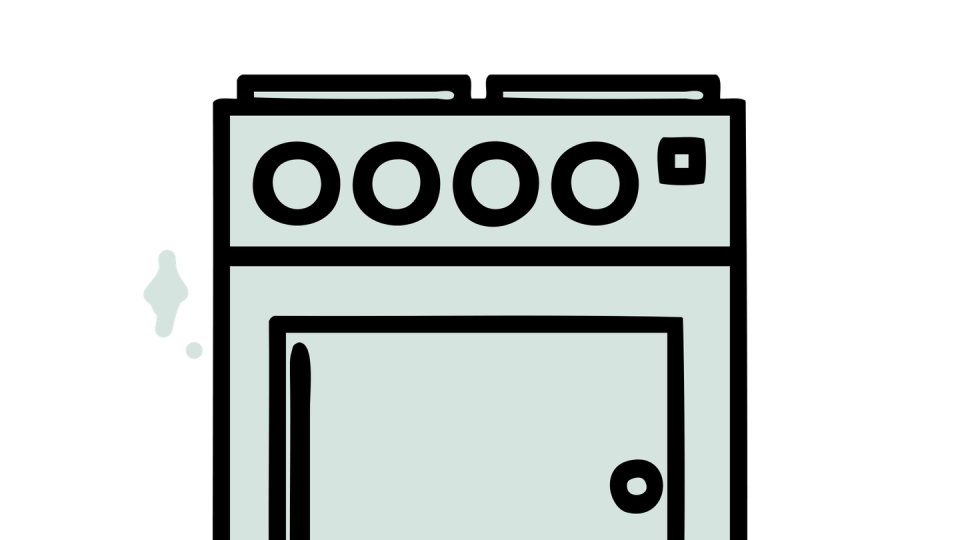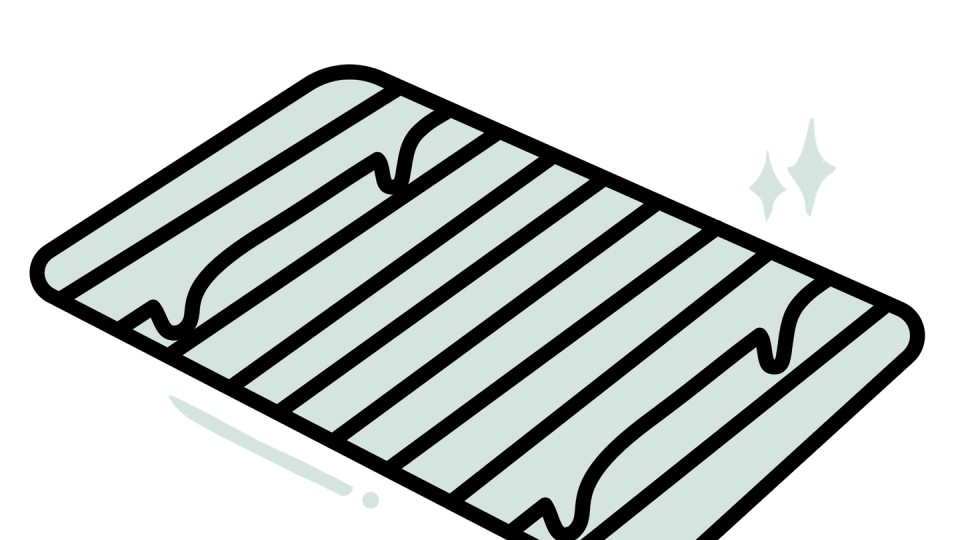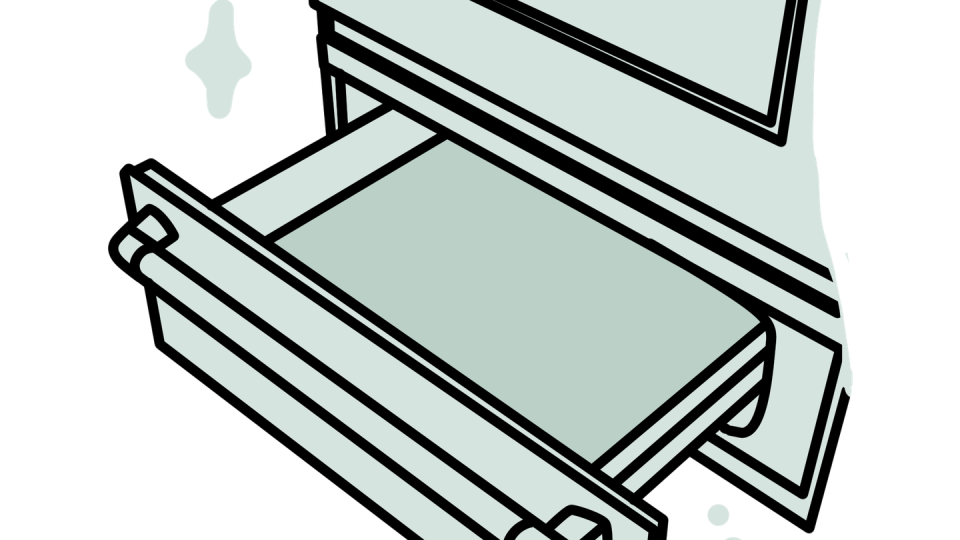This Is the Quickest (and Most Thorough) Way to Clean Your Oven
"Hearst Magazines and Yahoo may earn commission or revenue on some items through these links."
Whether you use your oven on a daily basis or á la Carrie Bradshaw to store winter sweaters, odds are it could use a good cleaning. From melted pizza cheese and fat dribbles to crumbs, your oven can turn into a health hazard quite quickly. Did you smell a weird burning last time you cooked your favorite sheet pan recipe? If so, it's definitely time to learn how to clean an oven.
Unfortunately, a lot more goes into it than simply wiping it down with an all-purpose cleaner. But by following the process below a few times a year, your food with taste better (no, really), and all of that grime and weird smelling ash will be a concern of the past.
Ahead, we're breaking down how to properly clean an oven with the help of two appliance experts: Chrissy Hogie, KitchenAid senior product marketing manager, and Amelia Hensley, GE Appliances director of cooking systems.
Types of Ovens
Depending on the layout of your kitchen, you either have a range (a single appliance that has a rangetop and oven) or a built-in wall oven (or two) and a separate rangetop or cooktop. You can use the same set of direction and same materials to clean all of these appliances. If you have a separate rangetop or cooktop and wall ovens, we still recommend tackling both units at the same time for the ultimate clean kitchen.

What You'll Need
Vacuum with hose attachment
Dish soap
Stainless steel cleaner (if you have a stainless steel range)
Wire brush
Oven cleaner (optional)
Safety Tips
Before cleaning your oven, make sure it's turned off—if possible, we recommend unplugging the unit completely—and if your oven runs on natural gas, that is turned off or disconnected as well. Hensley recommends you wipe off grease and remove loose food debris before starting the cycle. "A vacuum, either handheld or with a hose attachment, can be helpful to remove crumbs quickly," she says. "Always run the cycle for the maximum time allowed by your oven. While it is not necessary, some owners also open windows and/or run a kitchen ventilation hood to quickly remove food odors." For a range, remove the knobs to avoid turning the oven or stovetop on while cleaning it.
How to Clean an Oven Basics
This might sound obvious, but you need to remove everything in your oven before you clean it. Take out the broiler pan and racks as well as any cookware or bakeware stored inside.
Use a damp cloth to clean the doorframe edge, stopping about an inch and a half inside the oven, then wipe away any loose crumbs in the oven. This will help reduce any smoke you get when cooking and help your oven look pristine and last longer, explains Hogie. "Foods often react with porcelain at high temperatures, resulting in staining, etching, pitting, or faint white spots," she says. "It will not affect the oven's cooking performance, but it can be avoided."

The Knobs
Most oven knobs can be removed. Take them off and let them soak in a bowl of warm water and dish soap for 20 to 30 minutes. Rinse and polish with a microfiber cloth before placing them back on.

The Exterior
Spray an all-purpose cleaner or stainless steel cleaner onto the stovetop and door front and wipe clean with a microfiber cloth. Don't use an abrasive cleaners or textured cloth; they can scratch and damage the finish.

The Racks
Remove the racks from your oven and use a damp sponge or wire brush to scrape away any large debris, crumbs, or grease clumps. Hensley says, "One watch-out here: Some racks may come with a special lubricant for the ball bearings in the sliding mechanism—take care to not get water or cleaning products in the sliding mechanism," she says. "Also, some racks can stay in the oven during a self-cleaning cycle on the oven! Be sure to double check the product manual to be sure." If yours can stay in, put them back.
If the racks fit in your dishwasher, put them in and run a heavy-duty cycle. If not, fill your sink with warm water and dish soap and let them soak for a bit, rotating them if necessary, before scrubbing with a scouring pad or scrubbing sponge. Let them dry completely, then put them back in the oven.

The Interior
Mix up a baking powder paste using a one-to-one ratio of baking powder to water. Put on the gloves and spread the paste all over the inside of the oven (except for on any cooking elements, such as coils) and let dry for at least six hours. If you can leave overnight, even better! You can also use an oven-specific cleaner instead of baking powder if you'd like; simply follow the directions on the container.
Once the paste has dried in the oven, fill a spray bottle with vinegar. Using gloves and a damp cloth, spray down the dried paste with vinegar and wipe it off. (Depending on the state of your oven, it may take several rounds of vinegar to remove stubborn spots.) When the paste is all gone, wipe down the oven again with a clean, damp cloth, and replace the oven racks. Spray the door with a glass cleaner and/or stainless steel spray and wipe clean.

The Warming Drawer
That little section on the bottom of the oven that you use for storage or warming food (or not at all) probably needs a good clean too. Crumbs tend to accumulate inside. To clean the interior, remove any food or debris from the surface using a cloth or the vacuum, then wipe it down with a microfiber cloth dipped in warm, soapy water.
How to Clean an Oven With the Self-Cleaning Function
The steps to prepare an oven for its self-cleaning feature are similar to those mentioned above, except you don't unplug off the oven. Remove any surface debris with a damp cloth, sponge, or vacuum, and then program the "self-clean" feature to start. The entire process should take between three and five hours, Hogie says, depending on how dirty the oven is. The oven door will open automatically once the cleaning is finished and the appliance has cooled back down.
"Once the oven has completely cooled, you can remove any ash with a damp cloth," Hogie says. "To avoid breaking the glass, do not apply a damp cloth to the inner glass door before it has completely cooled."
After you've accomplished this task, you might be tempted to line the bottom of your oven with foil to avoid cooking on any future spills. Hogie says not to do this, though: "It may permanently damage the finish at the bottom of your oven."
If You Have a Steam Cleaning Setting
If you have an oven with a steam-clean feature, Hogie says it's important not to use any cleaners or additives during this process. "This feature is designed for light cleaning and is not intended to dissolve difficult soils," Hogie explains. "So steam clean an oven as soon as possible after spills occur. The longer a spill sits in an oven, the more difficult it may be to remove." Common spills include melted cheese, proteins, or sugars, Hogie says—and the two latter examples often require some elbow grease.
To use the steam cleaning function, pour 12 ounces of distilled or filtered water onto the bottom of the oven or into the steam reservoir if your range or oven has one. (Don't use tap water because it can leave mineral deposits on the oven floor.) Press the button associated with the steam-cleaning cycle, which should take about 50 minutes to complete. When the cycle is finished, open the oven door and use a sponge to wipe up any remaining water. If stains remain, use a nylon scrub to remove them.
"You can also pour vinegar or lemon juice on to the scrub to help remove any mineral deposits," she notes.
How to DIY an Oven Steam Clean
High-end culinary brands including French La Cornue and American BlueStar don't have self-cleaning cycles. La Cornue says its ovens are "built to last forever, and the intense concentrated heat used in a self-clean mode will break down the oven seal over time and compromise the efficiency of the oven." According to BlueStar, its ovens have a proprietary system that helps them to stay clean every time they're used. However, owners report that they have to use oven cleaner to get their BlueStar ovens clean.
If you have one of these ovens, you can easily DIY a steam clean with an oven-safe vessel (such as a casserole or baking dish) filled with distilled or filtered water and lemon slices. Place the vessel of water inside the oven at 450 degrees (232C) for 30 to 60 minutes to loosen and clean any grime and freshen the interior.
How Often Should I Clean My Oven?
GE recommends cleaning your oven every three to six months, spot checking in the interim for any rogue spills or crumbs.
Oven Cleaning FAQs
What Should I Not Use When Cleaning My Oven?
Never use an abrasive cleaner that can (and will) scratch the interior of your oven or harsh chemicals like bleach that can damage the interior coating and release dangerous fumes. Aside from loosening stuck-on debris on the metal racks, avoid using steel wool and harsh scouring pads. Oven interiors have a porcelain or stainless steel finish, and both can be damaged by steel wool.
What Areas of my Oven Should I Avoid?
Never ever use a cleaner on your oven's heating coils or let water get in your oven door's cracks. This can damage the function, performance, and integrity of your appliance.
Can I Use an Oven Cleaner With a Self-Cleaning Function?
No! Please don't. Your oven's self-cleaning function has everything it needs to clean itself. You should never add a cleaner or any chemicals on top of this process. Using an oven cleaner in a self-cleaning oven can corrode the oven's enamel coating. If you have a self-cleaning oven (not to be confused with a self-cleaning cycle in a regular oven), check your manual to find out which products are safe to clean with.
What is the best way to clean the inside of an oven?
Start by mixing a baking powder paste using a 1:1 ratio of baking powder to water. Using gloves, spread the paste all over the inside of the oven (do not spread on conduction coils!) and let dry for at least 6 hours. If you can leave overnight, even better! Once the paste has dried in the oven, prep a spray bottle with vinegar. Using gloves and a damp cloth, spray down the dried paste with vinegar and wipe down.
Does baking soda and vinegar really clean ovens?
Yes! An easy, household cleaning mix is to combine baking soda with water to create a paste and use that to clean the interior of your oven. This is safer than abrasive cleaners that can scratch and damage your oven’s finish, and it doesn’t contain any harmful chemicals.
You Might Also Like

